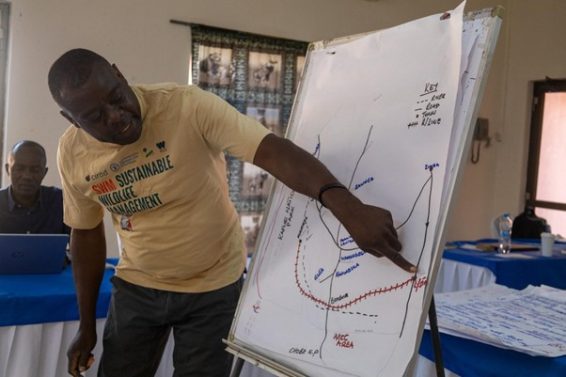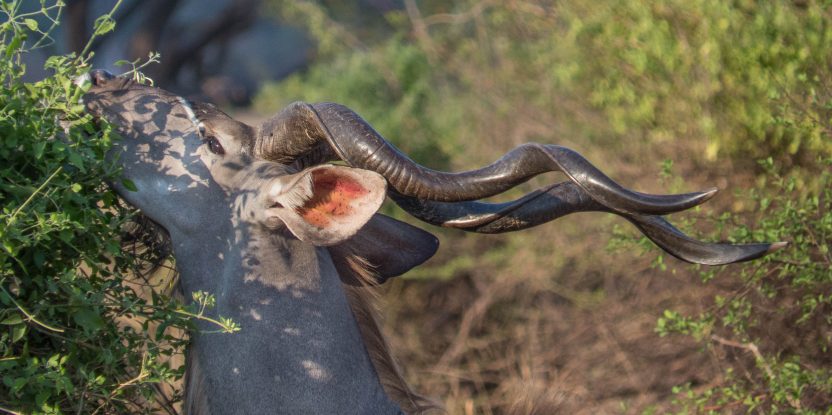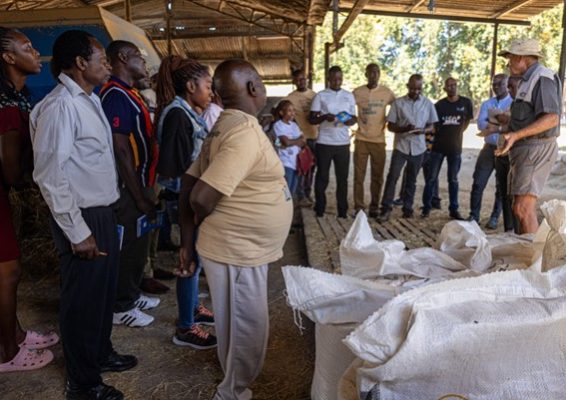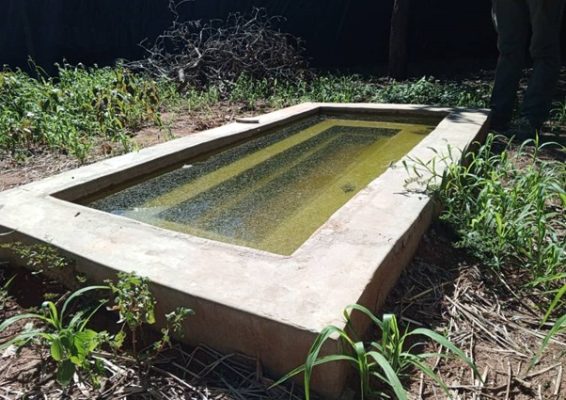Zambia is rich in natural resources and biodiversity, and efforts are intensifying to maintain harmonious coexistence between people and wildlife – a quest that’s essential for sustainable resource use and the mutual benefits it brings.
Along these lines, the 58,000-square-kilometre Mize Community Conservancy (MCC), in the Nyawa chiefdom of Kazungula District in southern Zambia, is dedicated to creating a peaceful environment where both humans and wildlife can thrive. The initiative is part of the Sustainable Wildlife Management (SWM) Programme, which is being implemented in a number of key biodiversity-rich locations around the world, including the Kavango-Zambezi Transfrontier Conservation Area (KAZA) – the second largest transboundary conservation in Africa, which spans the borders of Angola, Botswana, Namibia, Zambia and Zimbabwe.
To serve this end, a capacity-building training in game ranch management was held in the town of Mazabuka from April 22-25, 2024. Facilitated by the Wildlife Producers Association of Zambia (WPAZ), the training aimed to equip the 15 board members with the knowledge and skills necessary for setting up and managing a successful conservancy. Several activities are planned as business enterprises for the community within the conservancy, including 10,000 hectares that will be allocated towards the game ranch, and the remaining hectarage will cater for activities such as fish farming, beekeeping, and accommodation.

Board members of the Mize Community Conservancy sign in for hands-on training sessions, gaining valuable insights into game ranch management and sustainable wildlife practices. Photo by Lydia Amanzi/CIFOR-ICRAF
“MCC has the potential to explore various avenues,” said Nathalie Van Vliet, senior wildlife and livelihoods research associate at CIFOR-ICRAF, who stressed the importance of community decision making about which wildlife value chain to engage in. “This training was designed to put into perspective what they will eventually undertake.”
The four-day training provided a comprehensive overview of game ranch management, with emphasis on the practical aspects of daily operations. It covered a range of topics such as legal requirements, animal health management, translocation processes, and the economic aspects of game ranching, including income generation through trophy hunting, live sales, legal game meat production, photo tourism, and accommodation services.
Highlights included practical lessons on ecological assessments and game counts. Research Ecologist at DNPW, Barbara Luhana, remarked that game counts are important in overall management. “This is critical because it is the yardstick by which to measure changes in animal populations, calculate harvest numbers, and introduce management interventions where necessary.”
Participants also visited game ranches and learned about staffing, infrastructure, and the importance of clean water and appropriate feed. They were introduced to a network of experienced ranchers to facilitate information exchange and shared learning.
During the training, board member Stephen Sihoka emphasised the economic value of live animals over the losses incurred through poaching. “A live animal such as a kudu [woodland antelope] costs about USD 1875 or more, yet we have been tricked into selling them almost for nothing to illegal hunters,” he said. “This narrative must change. As a board member, I will work to educate my community on the value we are losing if we continue supporting these harmful practices.”
Neil Parsons, a seasoned veterinary doctor, underscored the importance of regular disease control of animals, which can become a serious problem if overlooked. “Disease control must be prioritised to ensure a healthy herd,” he said. Parsons later took the board members to his ranch, where they observed various bomas (game animal enclosures) that were built in various shapes to prevent animals from injuring themselves while under observation, and drinking pools built in particular ways to prevent animals from drowning.
The board also visited Kushiya Game Ranch. At the entrance, they undertook a mandated biosecurity measure involving a foot dip and vehicle spray – an act that re emphasised a habit they needed to adopt upon establishing their own community game ranch. Once inside, they toured the sugarcane plantation, dairy farm, butchery, and ecotourism facilities within the ranch, and farmer Guy Robinson showed them the strategic locations of mineral blocks, water points and feeding troughs within the ranch.
WPAZ Exco Member, George Van Wyk highlighted the need for proper facilities when hunting for meat sales, explaining that trained professionals must use specialised equipment and techniques to properly clean, trim, and prepare the meat for packaging and distribution, and that strict protocols must be followed to prevent contamination and ensure that the meat meets all food safety standards.
Van Wyk also shared insights on traceability, and the comprehensive tracking systems that are needed ensure the origin and provenance of game meat: each animal must be tagged and its journey meticulously documented from the initial field harvest to the final consumer product. This allows for effective monitoring, quality control, and the ability to quickly address any food safety concerns that may arise.
Rodgers Mungazi, a laboratory technician at the Ministry of Livestock and Fisheries, lamented the myth that diseases do not affect wildlife. “You are required by law to have wildlife tested to see if it is fit for consumption, because wildlife does suffer from diseases,” he said. “These policies are put in place for the sake of public health: one of the worst scenarios we’ve experienced was an outbreak of anthrax, which claimed many lives because people ate meat that was not approved for consumption.”
Like any other business, setting up a conservancy comes with its own costs. WPAZ Exco Member and Farm Manager, Jack Fairlie explained that running a game ranch can be expensive, and sufficient funds are needed. “The cost of setting up a game ranch is crucial to include when planning,” said Fairlie. “One has to factor in costs, including land, infrastructure, and facilities for clients.” His counterpart, Gavin Ross, meanwhile, emphasized the importance of knowing the game ranch or conservancy well. “You do not want your guests to know more about the species than your guide,” he cautioned.
The insights gained during the training inspired the MCC board to plan its next steps carefully, and offered a sense of hope that its wildlife resource management journey was on a positive track. “We identified areas where progress has been made, and areas that need improvement,” said MCC board chairperson John Simuuba. “We are eager to apply what we have learned.”

SWM Zambia community liaison officer Matthew Musanda points out landmark areas in MCC. Photo by Lydia Amanzi/CIFOR-ICRAF
About the Kavango–Zambezi Transfrontier Conservation Area and the SWM programme
The Kavango–Zambezi Transfrontier Conservation Area (KAZA TFCA) is the world’s largest transfrontier conservation area, spanning the international borders of five countries in Southern Africa. KAZA-TFCA is home to an incredible diversity of landscapes, communities, wildlife and a mosaic of protected areas. However, habitat fragmentation, recurring droughts, human-wildlife conflict and poaching threaten these fragile ecosystems.
To address these challenges, the global Sustainable Wildlife Management (SWM) Programme is supporting the establishment and strengthening of community conservancies to improve land-use planning, community livelihoods and sustainable wildlife management. This initiative, known as SWM Community Conservancy Project, is being implemented in Botswana, Namibia, Zambia and Zimbabwe.
We want you to share Forests News content, which is licensed under Creative Commons Attribution-NonCommercial-ShareAlike 4.0 International (CC BY-NC-SA 4.0). This means you are free to redistribute our material for non-commercial purposes. All we ask is that you give Forests News appropriate credit and link to the original Forests News content, indicate if changes were made, and distribute your contributions under the same Creative Commons license. You must notify Forests News if you repost, reprint or reuse our materials by contacting forestsnews@cifor-icraf.org.


